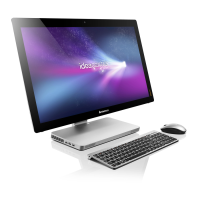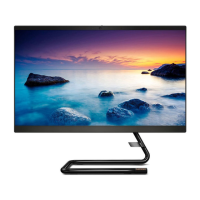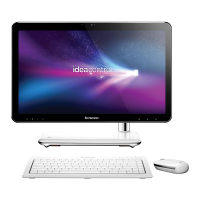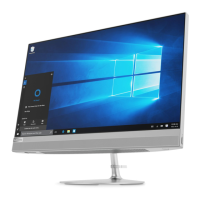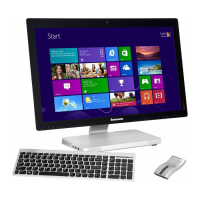
Do you have a question about the Lenovo IdeaCentre A730 and is the answer not in the manual?
| Bus type | DMI2 |
|---|---|
| Stepping | C0 |
| Tjunction | 100 °C |
| Processor code | SR15H |
| Processor cache | 6 MB |
| Processor cores | 4 |
| Processor model | i7-4700MQ |
| System bus rate | - GT/s |
| 64-bit computing | Yes |
| Processor family | Intel® Core™ i7 |
| Processor series | Intel Core i7-4700 Mobile series |
| Processor socket | PGA946 |
| Processor threads | 8 |
| Processor codename | Haswell |
| Processor frequency | 2.4 GHz |
| Processor cache type | Smart Cache |
| Processor lithography | 22 nm |
| Processor manufacturer | Intel |
| Processor front side bus | - MHz |
| PCI Express slots version | 3.0 |
| Processor boost frequency | 3.4 GHz |
| Processor operating modes | 64-bit |
| ECC supported by processor | No |
| PCI Express configurations | 1x16, 2x8, 1x8+2x4 |
| Thermal Design Power (TDP) | 47 W |
| Maximum number of PCI Express lanes | 16 |
| Memory types supported by processor | DDR3-SDRAM |
| Memory channels supported by processor | Dual |
| Memory clock speeds supported by processor | 1333, 1600 MHz |
| Memory bandwidth supported by processor (max) | 25.6 GB/s |
| Maximum internal memory supported by processor | 32 GB |
| Internal memory | 8 GB |
| Memory clock speed | 1600 MHz |
| HDD speed | 5400 RPM |
| Storage media | HDD |
| Optical drive type | Blu-Ray ROM |
| Total storage capacity | 1000 GB |
| Compatible memory cards | - |
| Number of storage drives installed | 1 |
| Display diagonal | 27 \ |
| Touch technology | Multi-touch |
| Native aspect ratio | 16:9 |
| On-board graphics card ID | 0x416 |
| On-board graphics card model | Intel® HD Graphics 4600 |
| On-board graphics card family | Intel® HD Graphics |
| Maximum on-board graphics card memory | 1.74 GB |
| On-board graphics card base frequency | 400 MHz |
| On-board graphics card DirectX version | 11.1 |
| On-board graphics card dynamic frequency (max) | 1150 MHz |
| Number of displays supported (on-board graphics) | 3 |
| Total megapixels | - MP |
| Camera resolution | 1280 x 720 pixels |
| Dolby technologies | Dolby Home Theater v4 |
| Wi-Fi standards | 802.11b, 802.11g, Wi-Fi 4 (802.11n) |
| Ethernet LAN data rates | 10, 100, 1000 Mbit/s |
| USB 2.0 ports quantity | 0 |
| Product color | Gray |
| Processor ARK ID | 75117 |
| Intel TSX-NI version | 0.00 |
| Processor package size | 37.5 x 32 x 1.6 mm |
| Supported instruction sets | AVX 2.0, SSE4.1, SSE4.2 |
| Intel Identity Protection Technology version | 1.00 |
| Product type | All-in-One PC |
| Operating system installed | Windows 8 |
| Depth (with stand) | 220 mm |
|---|---|
| Width (with stand) | 650 mm |
| Height (with stand) | 480 mm |
| Weight (with stand) | 11000 g |
Provides crucial safety guidelines for servicing the computer.
Outlines essential rules for ensuring overall safety during maintenance.
Details precautions and hazards related to electrical components and power.
Provides a checklist for inspecting the computer for potential hazards.
Explains procedures to prevent damage from static electricity to sensitive parts.
Specifies necessary grounding procedures for operator safety and system function.
Introduces the safety warnings provided in the manual.
Lists the physical and environmental specifications for the computer.
Guides users on how to access and launch the BIOS setup utility.
Explains how to navigate and modify system configuration settings in the BIOS.
Describes the function and types of passwords for system security.
Details setting, changing, or deleting the Administrator password.
Details setting, changing, or deleting the Power-On password.
Instructions for enabling or disabling system hardware devices via BIOS.
Procedures for choosing the boot device for system startup.
Steps for saving changes or discarding them before exiting the BIOS setup.
Lists causes and actions for hard disk drive boot failures.
Outlines procedures for diagnosing and resolving power supply issues.
Explains Power-On Self-Test (POST) error messages and their resolutions.
Provides a systematic approach to diagnose unknown system issues.
Identifies controls and components on the front of the computer.
Identifies connectors and components on the sides of the computer.
Identifies connectors and components on the rear of the computer.
Illustrates and lists the internal components of the computer.
Details connectors and components located on the motherboard.
Identifies components on the rear side of the motherboard.
Shows components and controls on the back of the LED panel assembly.
Essential steps to take before beginning hardware disassembly.
Step-by-step guide for replacing the keyboard and mouse components.
Instructions for replacing the external power cord and adapter.
Procedure for safely removing the computer's base cover for access.
Detailed steps for removing and replacing the hard disk drive.
Guide for installing or replacing RAM modules.
Instructions for replacing the internal cooling fan.
Procedure for removing and installing the heat-sink assembly.
Steps for replacing the CD/DVD or Blu-ray drive.
Detailed instructions for replacing the Central Processing Unit (CPU).
Guide for replacing the SSD or other flash storage.
Procedure for replacing the mechanism that ejects optical discs.
Comprehensive steps for replacing the main system board.
Instructions for replacing the internal speaker components.
Steps for installing or replacing the TV tuner hardware.
Procedure for replacing the CMOS battery.
Steps to detach the display hinge mechanism from the computer chassis.
Procedure for safely removing the rear panel of the computer.
Instructions for replacing the scalar board, which handles video signals.
Guide for replacing the touch interface control board.
Procedure for replacing the board that converts power or signals.
Instructions for replacing the board containing the power button.
Steps for replacing the Bluetooth wireless communication module.
Guide for replacing the Wi-Fi wireless network card.
Procedure for replacing the integrated webcam.
Instructions for replacing the board with front-mounted controls.
Steps for replacing the entire LED display panel assembly.
Lists of Field Replaceable Units (FRUs) with part numbers and CRU status.
Provides supplementary information relevant to service personnel.
Explains how power management features reduce component power consumption.
Discusses the role of ACPI BIOS in managing system power features.
Describes features that allow the computer to turn on automatically.
